Canon PowerShot A2300 review
-
-
Written by Ken McMahon
Intro
The Canon PowerShot A2300 is a budget point-and-shoot-compact introduced in January 2012. It has a 16 Megapixel CCD sensor and a 2.7in screen with 230k pixels. The 5x zoom boasts a 28mm wide angle and a bright f2.8 maximum aperture, an improvement on the 4x zooms of the 2011 budget PowerShots. The A2300 lacks the optical image stabilisation of higher end PowerShot and IXUS models, but Canon has provided a low light stacking mode that it calls ‘Digital IS’.
If the A2300 is to replace last years A2200, then Canon hasn’t yet removed it from the PowerShot range. When it was released, the 14 Megapixel, 4x zoom A2200 was the slimmest A series compact yet produced, but the A2300 is slimmer and lighter still.
It’s not the least expensive nor the most basic PowerShot, that honour belongs to the larger and heavier PowerShot A810 (and the optical viewfinder equipped A1300) which is powered by a couple of AA batteries. Moving up the range, the PowerShot A2400 IS shares almost the exact same specification, but adds optical image stabilisation. The other two models are the touch-screen A3400 IS and the top of the range PowerShot A4000 IS with an 8x zoom and 3 inch LCD screen.
In this review I’ve compared the A2300 with its more capable stablemate the A3400 IS. The A2300 and A2400 IS are similar in all but optical image stabilisation and there’s only a few dollars difference in price, so it’s an easy call to decide whether that’s worth it to you. But the PowerShot A3400 IS has more to offer than optical image stabilisation, it boasts a 3 inch touch screen. Read my full review to discover whether those features are worth paying the extra for, or if the budget A2300 is the ultimate value for money PowerShot.
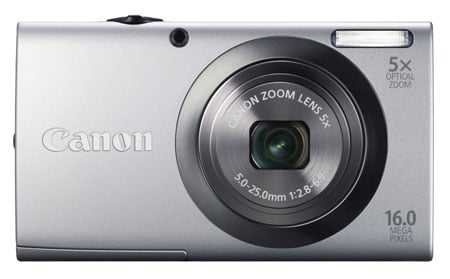 |
Canon PowerShot A2300 Design and controls
Every year the budget PowerShot A range seems to grow closer in design to Canon’s premium IXUS / ELPH range and, from the front at least, it would be easy to mistake the PowerShot A2300 for an IXUS / ELPH. The bold styling that used to define A series PowerShots has been gradually toned down and the front of the A2300 is comparatively featureless. No two tone colour scheme, no raised or bulging handgrip, just a plain elegant expanse of silver, red, black or blue plastic with the raised Canon badge providing something for your fingers to gain a purchase on.
The front surface curves gently round to the top and bottom panels and the effect resembles a bar of soap – at least if they made very slim bars of soap. The retracted lens sits flush with the front panel and the only other features here are the built-in flash and an LED AF illuminator. The back of the A2300 is finished in matt black and it doesn’t look quite as elegant as the front, or for that matter as the two tone A3400 IS, the raised and bevelled LCD panel gives it a slightly dated look.
The control layout is functional with a four-way controller at the centre and four glossy black buttons surrounding it. There’s a dedicated movie record button and alongside it a button labelled with a question mark which activates the on-screen help system. To dedicate one of only a handful of external controls to the help system shows that this model is squarely aimed and beginners and casual snappers. The two remaining buttons below the four-way controller activate playback and the the menu system.
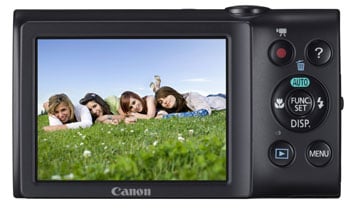 |
The PowerShot A2300’s 2.7 inch LCD screen has 230 thousand pixels, in terms of specification this is now pretty much the de facto standard for budget compacts and while it obviously doesn’t provide as big and clear a view as the 3 inch touch screen on the A3400 IS, it’s bright and contrasty and you have to look hard to notice the slight pixellation that’s visible on a screen with this resolution.
Like all screens the A2300’s can be difficult to see in bright sunlight but I was disappointed to discover that it also has quite a narrow viewing angle both horizontally and vertically. That means that you can’t see a great deal if you hold the camera above your head to shoot, plus if you want to review shots with friends you’ll need to pass them the camera as they won’t be able to see properly from either side of you.
The A2300 has a built in flash unit located on the top left of the front panel – you need to take care not to cover it with your left index finger. It has a maximum range of three metres at the wide angle zoom setting and takes about four seconds to recycle between shots. Unusually for a point-and-shoot compact, Canon provides not one, but two optional flash attachments, the HF-DC1 and HF-DC2.
A door on the right of the bottom panel houses the slim NB-11L battery which provides enough power for 210 shots under CIPA (Camera Imaging Products Association) standard conditions, a little on the low side, but then it is a very small and light battery. The SD card slot sits just behind the battery, the A2300 takes SD, SDHC and SDXC cards.
On the right of the camera body a small plastic door covers the combined USB and A/V out port. This takes a USB cable for transferring photos and video to your PC and can be used with the optional AVC-DC400 cable to connect the A2300 to a TV with a composite video port.
Canon PowerShot A2300 lens and stabilisation
The PowerShot A2300 is equipped with a 5x optical zoom lens with a 28-140mm equivalent range. Like the earlier PowerShot A2200 it starts at a very useful 28mm wide angle but now extends a little further – 140mm compared with 112mm. With the exception of the 8x top of the range PowerShot A4000 all 2012 A Series PowerShots now sport 5x optical zooms.
While the difference between 4x and 5x doesn’t sound all that much, 140mm extends the zoom reach beyond the portrait capabilities of the earlier budget A Series PowerShots and enables you to get a little closer to distant action. But while 140mm is good for the zoo, or, say, indoor school sports events, it won’t cut it for serious wildlife photography or stadium events, for that you’ll need to set your sights higher, maybe on the 8x PowerShot A4000.
The zoom extends quickly and smoothly through the range and there’s a 4x digital zoom indicated on screen by an extended zoom bar. The digital zoom crops the frame and seriously degrades the image quality, but it can easily be disabled.
Canon PowerShot A2300 coverage wide | Canon PowerShot A2300 coverage tele | |
 | 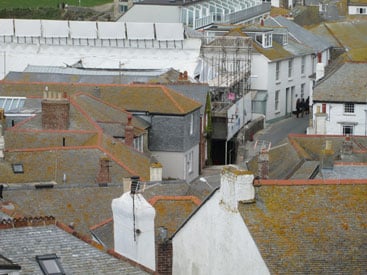 | |
| 5-25mm at 5mm (28mm equivalent) | 5-25mm at 25mm (140mm equivalent) |
The PowerShot A2300 lacks optical image stabilisation, but Canon has introduced something new which it calls ‘Digital IS’. This takes a sequence of three shots in quick succession and produces a composite image corrected for camera shake. Previously the only stacking mode we’ve seen on Canon compacts is the Handheld NightScene mode available on HS models equipped with a CMOS sensor, so it’s good to see Canon taking the initiative and providing an alternative to optical image stabilisation for its budget A Series models. Having said that, Digital IS is a bit of a let down. Firstly it’s a reduced resolution mode, producing 4 Megapixel images with a size of 2304 x 1728 pixels. Secondly, it automatically sets the ISO sensitivity quite high so as to minimise the effect of camera shake to start with.
The crops below are from shots taken with the A2300’s lens zoomed to the maximum 140mm focal length. The crop on the left was taken in Program auto mode with the sensitivity set to 100 ISO with an exposure of 1/60th at f6.4. The one on the right was taken in Digital IS scene mode. There’s a little bit of camera shake in the left crop and Digital IS has undoubtedly produced a sharper shot, but a better result at full resolution could almost certainly have been achieved by simply increasing the ISO to 200 or 400, or alternatively switching to Smart Auto mode, which would do the same thing for you.
Alternatively if you love everything about the A2300, but wish it had optical stabilisation, then there’s the otherwise identical A2400 IS.
Canon PowerShot A2300 Program auto vs Digital IS mode | ||||
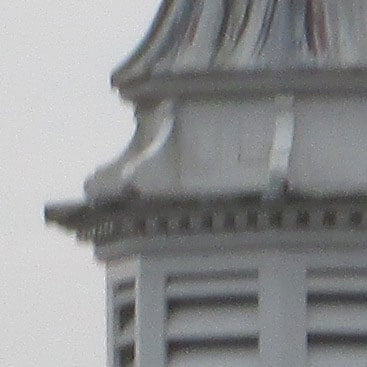 |  | |||
100% crop, 5-25mm at 25mm, 100 ISO 1/60th Program auto mode | 100% crop, 5-25mm at 25mm, 1600 ISO 1/1000th, Digital IS mode | |||
Canon PowerShot A2300 shooting modes
Unlike the PowerShot A2200, the A2300 lacks an external mode dial so the shooting mode selection is relegated to the top position on the four-way controller. This switch toggles between Auto mode and either Program mode or whatever the current alternate shooting mode is. In Auto mode the Digic 4 processor uses scene detection to determine the best exposure. It works by dividing scenes into those that either do or don’t contain people, and determines whether there’s any subject movement before then analysing the lighting conditions. The Digic 4 can tell if the subject is backlit, spotlit, if there is blue sky in the frame and if you’re shooting a sunset. It can also determine if you’re shooting in the dark and whether you have the camera attached to a tripod. Finally it keeps track of focus as well as exposure so can tell if you’re lining up a macro shot.
All of this works very smoothly in practice though the A2300 isn’t infallible. When it detects motion in the frame it automatically switches to tracking AF, but mere camera movement often fools it into doing this and it also occasionally gets the lighting conditions wrong. Ninety percent of the time though it works well and produces great results.
Switch out of auto mode and you have the choice of Program mode with control over ISO sensitivity, Exposure compensation, White Balance, and image size among other things. Novice shooters might feel more comfortable with Live View control, which provides three sliders for control of exposure compensation (Dark/Light), saturation (Neutral/Vivid) and white balance (Cool/Warm).
| Canon PowerShot A2300 Creative Effects | ||
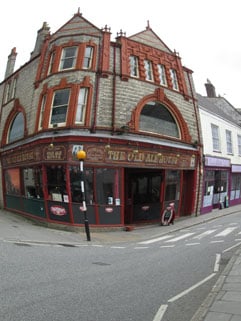 |  |  |
The usual Canon Scene modes are included as are what used to be called Creative effects – Miniature, Monochrome, Poster and, shown above, Fisheye, Toy camera and Super vivid. Also Included is Canon’s Face Self-timer function which starts the countdown when a new face enters the frame, so you don’t need to make a dash for it.
Canon PowerShot A2300 movie modes
The A2300 can shoot HD quality movies at 720p resolution at 24 / 25fps depending on region. Movies are encoded using the H.264 codec at an average of 18 Megabits per second and saved as QuickTime (.mov) files. There’s also a standard definition movie mode thats records 640×480 clips at 30fps.
The optical zoom can’t be used during recording, which is a bit of a disappointment, only the 4x digital zoom is operational during movie shooting and resulting drop in quality means you’ll probably want to avoid it. On a more positive note, any changes you make in Live control mode are retained when you press the movie record button, so you can adjust the exposure, white balance and saturation for movies. You can also use some of the creative effects for movie shooting including the Miniature mode, one of the best and most versatile faux tilt-shift effects on any compact. As well as selecting a horizontal or vertical focus zone, you can shoot for one of three playback speeds – 5x, 10x or 20x.
Canon recommends a minimum class 6 speed card for video recording and the maximum HD recording time on my european review model was a second short of 30 minutes.
| |
|---|---|
|
Outdoors the A2300’s 720p25 HD video looks good, but the lack of stabilisation even at the wide angle setting shows.
| |
|---|---|
|
Things are a lot smoother for this tripod-mounted panning shot, but the mono mic is quite prone to wind noise and there’s no wind cut filter.
| |
|---|---|
|
In this indoor low light panning shot the PowerShot A2300 isn’t as responsive to changing lighting condition as earlier PowerShots. There’s some visible noise in the frame and, once again, the absence of video stabilisation is obvious.
| |
|---|---|
|
The A2300 can shoot video using some Creative Effects filters. Here’s Miniature mode with playback at 10x producing a six second clip from a minute’s worth of shooting. Other options are 5x and 20x. If the photo aspect ratio is set to 4:3, then these modes will record video at VGA 640×480 pixels, but if you set the photo aspect ratio to 16:9 before recording, the video will be recorded in 720p HD.
Canon PowerShot A2300
handling
The PowerShot A2300 starts up and is ready to take a shot in two and a half seconds, a fairly average wait for cameras in this price bracket. Without a mode dial or button the menu system has to provide mode switching functions in addition to everything else, which could, but doesn’t, create problems. The AUTO position at the top of the four way controller switches between Auto mode and the currently selected the alternate mode listed on the first ribbon of the Func shortcut menu. So the AUTO button toggles between Auto and Program, Live Control, Digital IS or one of the Scene or Creative Effects modes – you just pick the one you’re most likely to need. And if it turns out you need something different, that’s easy enough to find on the Func menu.
About the only drawback of this setup is that there’s no dedicated position on the four-way controller for the self-timer functions. The help button provides context-sensitive concise well-written advice and hints on each of the camera’s features and functions along with a little schematic showing the position of the controls which are described. It’s a big improvement on the previous hints and tips system.
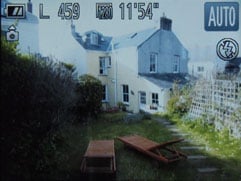 | 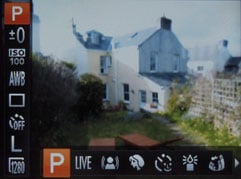 | 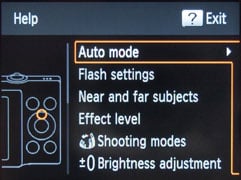 |
The A2300’s Auto focussing is pretty sure of itself both in Face AiAF mode and the nine area AF it defaults to when there are no faces in the frame. Like all such systems it relies on good light and reasonable proximity to the subject, but even in low light it’s functional if a little slow. The manual says the A2300 can shoot at 0.8 fps in continuous mode and that’s exactly what it achieved in testing. Canon’s compacts are not known for fast continuous shooting, and so the fact that the A2300 can’t even manage to fire off a frame every second comes as no great surprise. If you switch it into low light mode, though, you can get nearly 3fps, albeit at 4 Megapixel resolution and high ISO sensitivities.
The A2300’s 16 Megapixel CCD sensor produces images with 4608×3456 pixels. Images are JPEG compressed to produce files with an average size of around 3.5MB. The ISO sensitivity ranges from 100 to 1600 ISO and the shutter Speed range is 15 to 1/2000.
To see how the quality of the PowerShot A2300 measures-up in practice, take a look at my Canon A2300 quality and Canon A2300 noise results pages, browse my Canon A2300 sample images, or skip to the chase and head straight for my verdict.




